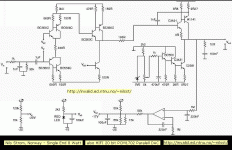I seached the web, and came across a very interesting homepage.
It is a private norwegian guy, Nils Strøm.
He has only 2 projects, but both are very interesting, I think.
Single End 8 Watt Solid State Amplifier,
without global AC feedback.
Also a High End 20 bit DAC, using parallelled PCM1702.
Battery Powered Analog part of the Circuit.
---------------------------------
Links:
Nils Strøm, Norway - Homepage
Single Ended Solid-State Amplifiers
20 bit High End DAC with PCM1702 - pdf
------------------------------------
Below is the schematic to the unusual 8 watt SINGLE END solid state amp.
This schematic is also at my FTP-site now.
/halo - Big FAN of Norway! 😉
It is a private norwegian guy, Nils Strøm.
He has only 2 projects, but both are very interesting, I think.
Single End 8 Watt Solid State Amplifier,
without global AC feedback.
Also a High End 20 bit DAC, using parallelled PCM1702.
Battery Powered Analog part of the Circuit.
---------------------------------
Links:
Nils Strøm, Norway - Homepage
Single Ended Solid-State Amplifiers
20 bit High End DAC with PCM1702 - pdf
------------------------------------
Below is the schematic to the unusual 8 watt SINGLE END solid state amp.
This schematic is also at my FTP-site now.
/halo - Big FAN of Norway! 😉
Attachments
Global feedback
Am I delirious or the DC servo is not considered a global AC feedback?
Nothing against it, just curious.
Carlos
halojoy said:
He has only 2 projects, but both are very interesting, I think.
Single End 8 Watt Solid State Amplifier,
without global AC feedback.
Am I delirious or the DC servo is not considered a global AC feedback?
Nothing against it, just curious.
Carlos
the DC servo is not considered a global AC feedback?
A 100uF cap decouples the AC component in the global feedback signal Vb2, so there should be no audio global feedback.
Cheers,
Great effort, but horrifically complex for the job it is doing.
Slavish use of CFPs throughout without too much regard for the linearity of the output stage whose driver will have a widely varying current.
Probably sounds OK; CFPs at constant current are reasonably stable. Input stage seems very complex; can't see the point of going beyond a simple diff pair, myself.
Cheers,
Hugh
Slavish use of CFPs throughout without too much regard for the linearity of the output stage whose driver will have a widely varying current.
Probably sounds OK; CFPs at constant current are reasonably stable. Input stage seems very complex; can't see the point of going beyond a simple diff pair, myself.
Cheers,
Hugh
- Status
- Not open for further replies.
